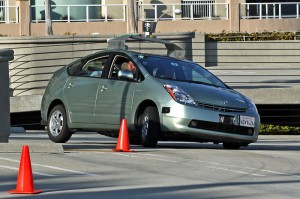As I was driving on the I-40 interstate the other day, I noticed how of the 12 feet of concrete devoted to a travel lane, the typical car or truck only touches two, one-foot-wide strips where the tires are. What a waste of the other 10 feet of concrete.
It made me realize how little the car has changed since it was first introduced. Oh, sure, plenty of progress has been made to the inside of the car, but what about the rest of what it takes to make a car go: the infrastructure? There are so many things we could be doing with cars but haven’t yet tried.
Why do we still build roads? All that impervious, land-hogging, surface, and only a fraction of it is useful to any vehicle. Well, the Romans did it, some might say, but thats because stones were all they had.
What about something that runs on tracks instead? We build highways with long stretches of straight pavement and permanent exits. There’s no reason why cars need to move independently on a highway. A track system could guide cars along without need for driver interaction. Multiple cars could “tailgate” on these tracks without any danger of collision. This is stuff that wasn’t possible during Roman times and not even when the interstate highway system was built in the 1950s, but we could do it now. It’d be like the car rides at an amusement park.
Yesterday near Gainesville, Florida there was a horrific traffic pileup on I-75 in which 10 people died. Drivers apparently got blinded by smoke and fog and others slammed into them. If cars were guided on tracks instead, they might have moved smoothly through the smoke and fog without incident.
Millions of drivers can expertly navigate nearly any city through the use of GPS-based navigation systems. Google has created an experimental car which can drive itself. At the same time, gas prices are skyrocketing, roads are gobbling up land, deadly accidents are commonplace, and yet we’re still driving what is essentially a glorified Roman oxcart.
Isn’t it time to reconsider how we get around? If you could design a transportation system for the planet starting completely from scratch, what would it look like?
